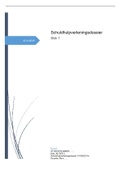College aantekeningen
Political Communication & Journalism Summary (Lectures + Literature)
- Vak
- Instelling
The notes are a comprehensive summary of the information from the literature and lectures of the Political Communication and Journalism course. As they include references for all scientific articles that were exam material, these notes are especially helpful for open-book exams. The notes helped se...
[Meer zien]







